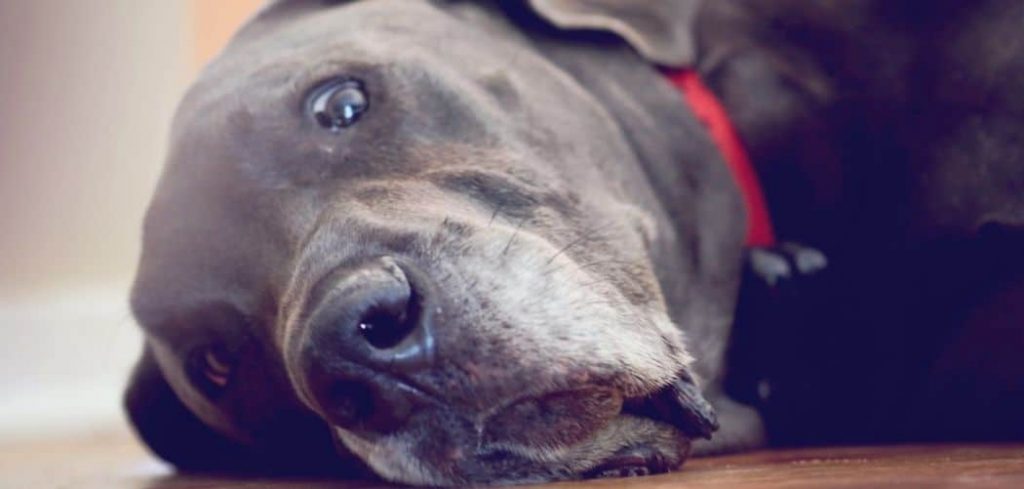It can be very concerning when your Great Dane is not excited about anything and seems sad. Just like us, Great Danes can get depressed.
Depression causes sadness and a lack of excitement for activities or life. It can be hard to tell if your Great Dane is experiencing depression, but there are signs to look out for to know their mental state and if they are depressed.
So, is your Great Dane depressed?
Let’s dive into what to look out for to determine a depressed Great Dane.
Is My Great Dane Depressed?
Great Danes do get depressed and the signs include hiding, disinterest, loss of appetite, change of sleep habits, and excessive paw licking. Some of these signs are also displayed if there is an underlying health problem therefore it is important to get them examined to rule out any underlying problems.

Great Dane depression can be treated with medication, enrichment of their environment and behavior modification.
What Causes Depression in Great Danes?
Several factors can contribute to your Great Dane feeling down. Here are some common reasons:
1. Sudden Changes in Environment
Great Danes are sensitive to their surroundings. A recent move, new family members, or even rearranging furniture can cause them to feel uneasy and withdrawn.
2. Loss of a Companion
Whether it’s a human family member or another pet, loss can deeply affect Great Danes. They form strong bonds and may grieve just like humans do.
3. Lack of Exercise and Mental Stimulation
As large and intelligent dogs, Great Danes require regular exercise and mental engagement. Without proper activity, they can become bored and lethargic, leading to symptoms of depression.
4. Neglect or Loneliness
Great Danes thrive on companionship. If they are left alone for extended periods without interaction, they may become sad and withdrawn.
5. Underlying Health Issues
Sometimes, depression-like symptoms can stem from medical conditions. Joint pain, digestive issues, or hormonal imbalances could be making your dog feel low.
Related: Is my Great Dane dying?
Signs of Depression in Great Danes
If you suspect your Great Dane is depressed, look for these common symptoms:
Loss of Appetite – A sudden decrease in food intake can indicate emotional distress.
Lethargy and Low Energy – Depressed dogs may sleep excessively and show little interest in activities they once enjoyed.
Avoidance or Hiding – If your dog isolates themselves or avoids interaction, they could be feeling emotionally unwell.
Excessive Licking or Chewing – Compulsive behaviors like licking paws can be a sign of stress or sadness.
Changes in Sleeping Patterns – Sleeping too much or struggling to rest can both indicate depression.
Unusual Vocalization – Excessive whining, sighing, or howling could be a cry for attention or an expression of sadness.
Lack of Interest in Play – A once-playful Great Dane showing little enthusiasm for toys or walks might be experiencing depression.
How to Help a Depressed Great Dane
If you believe your Great Dane is struggling with depression, there are several ways to support them.
1. Increase Physical Activity
Regular walks, playtime, and engaging activities can help lift your dog’s mood.
Try varying your routine with new walking paths or interactive toys.
2. Spend Quality Time Together
Great Danes crave companionship.
Set aside dedicated time for belly rubs, training sessions, or simply sitting together to provide emotional comfort.
3. Provide Mental Stimulation
Boredom can contribute to depression.
Puzzle toys, treat-dispensing games, or obedience training can keep your dog engaged and happy.
4. Consider a Canine Companion
If your Great Dane is grieving the loss of a pet or experiencing loneliness, introducing another dog (if feasible) might help boost their spirits.
5. Stick to a Routine
Dogs thrive on consistency. Establishing a predictable schedule for feeding, walks, and playtime can create a sense of security and stability for your Great Dane.
6. Check for Underlying Health Issues
If depression symptoms persist, consult a veterinarian. Pain or medical conditions like hypothyroidism could be contributing to their low mood.
7. Introduce New Experiences
Sometimes a change of scenery, such as a trip to the dog park or a new hiking trail, can rejuvenate your Great Dane’s interest and enthusiasm.
When to See a Veterinarian
If your Great Dane’s symptoms persist for more than a few weeks or worsen over time, it’s best to seek professional help.
A vet can assess their health and recommend behavioral strategies or, in some cases, medication to help manage depression.
Conclusion
If you’ve been asking yourself, Why is my Great Dane acting sad? or How do I know if my Great Dane is depressed?, paying attention to behavioral changes and potential causes is the first step.
With patience, love, and proactive care, you can help your gentle giant regain their happiness and well-being.
